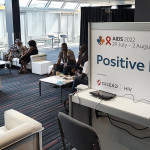Yokohama, Japan, site of the 10th International Conference on AIDS, is an ancient city with pockets of pure Japan: Bright red torii gates straddling the beach, temple courtyeards thick with sweet senkoh incense and Mount Fuji peeking over the horizon on a clear day. Most of the city, however, was built in the past three decades and the architecture bears a familiar stamp of industrial progress. Its boxy, glass office buildings and street-corner convenience stores could stand in Houston or Los Angeles. I worried that this observation might foreshadow the whole AIDS Conference: It doesn’t appear we’ve come very far.
I’m not sure if the International AIDS Conferences tend to reflect or to create the mood of those battling the epidemic. I arrived in Yokohama with very low expectations of exciting revelations about HIV. Yet I boarded my plane for the States with more optimism than I had felt after either of the conferences in Amsterdam or Berlin. But why? Because I had lower expectations? Or because there was actually more encouraging news presented at this conference? Unfortunately, as with all things related to HIV, the answer is unclear, and probably both.
I saw one major scientific breakthrough, however, and it wasn’t reported in The New York Times -- which admittedly isn’t saying much. I noticed that activists, scientists and policymakers are finally, tentatively, beginning to tell the truth about how much and how little they know about this disease. And when ego gives way to reality, the real research can begin.
Good news wasn’t scarce in Yokohama. Women’s issues, which were paid lip service last year in Berlin, emerged as the hot topic. Probably the most publicized presentation concerned the already-stale data showing that AZT could substantially decrease the risk of an HIV positive mother passing the virus to her unborn child. Major progress was also made on woman-controlled HIV prevention methods, such as the female condom and vaginal microbicides (creams that may kill HIV).
The hot topic of last year, people who show few signs of infection after 12 or more years of infection (called long-term non-progressors), also received much play in Yokohama. One of the chief researchers of long-term non-progression, Jay Levy of the University of California, announced last year a theory that CD8 cells, the samurai of the immune system that directly attack foreign organisms, produce some as-yet-unidentified chemical that inhibits HIV replication. This year, he announced that he had isolated it. His research suggests the chemical acts early in HIV infection to keep the amount of HIV in the body low and to suppress the emergence of more deadly strains. His discovery, if verified, may lead to effective immune-based therapies.
I was deeply disturbed, however, by a trend that just seemed to be verified by the tight focus on women’s issues: I call it the “at-risk group of the year” approach to epidemiology. As women and heterosexuals become increasingly drawn into the epidemic, attention is rightfully shifting toward them. But this doesn’t mean that attention must shift away from gay men. The most important example of this trend: Constant talk about the changing face of AIDS, rather than the expanding face of AIDS. We must continue to address the needs of women and people of color while not neglecting any of the other infected communities.
I left Japan with a tremendous amount of sadness and a degree of cautious optimism. Sadness because this conference offered no cure, no vaccine and no effective treatment. Cautious optimism because I believe that some of the advances presented in Yokohama are laying groundwork for significant change.
For advocates and activists, possibly the most useful message of the week was an observation made by Patsy Fleming, the interim U.S. AIDS policy coordinator. “If good intentions and stirring speeches were enough,” she told a disheartened audience at the closing plenary, “We would have triumphed long ago. Let’s be honest with ourselves. Every one of us can do more. Every one of us must.”
Rising Sun?
Mixed signals from Yokohama’s International AIDS Conference






Comments
Comments